Hyundai Elantra 2018 Service Manual
Manufacturer: HYUNDAI, Model Year: 2018, Model line: Elantra, Model: Hyundai Elantra 2018Pages: 526, PDF Size: 17.2 MB
Page 41 of 526
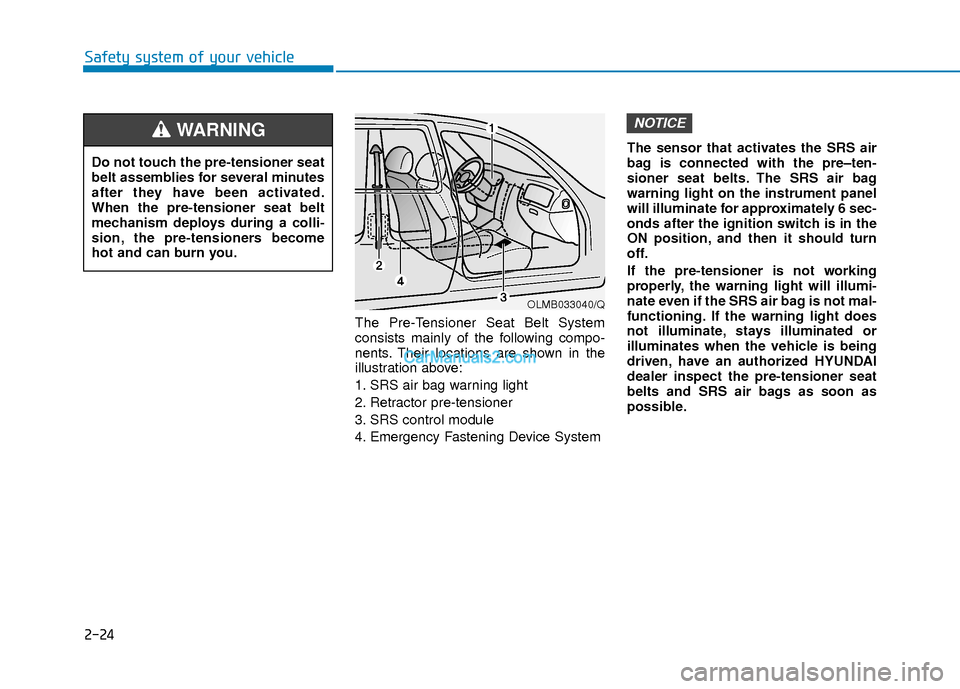
2-24
Safety system of your vehicle
The Pre-Tensioner Seat Belt System
consists mainly of the following compo-
nents. Their locations are shown in the
illustration above:
1. SRS air bag warning light
2. Retractor pre-tensioner
3. SRS control module
4. Emergency Fastening Device SystemThe sensor that activates the SRS air
bag is connected with the pre–ten-
sioner seat belts. The SRS air bag
warning light on the instrument panel
will illuminate for approximately 6 sec-
onds after the ignition switch is in the
ON position, and then it should turn
off.
If the pre-tensioner is not working
properly, the warning light will illumi-
nate even if the SRS air bag is not mal-
functioning. If the warning light does
not illuminate, stays illuminated or
illuminates when the vehicle is being
driven, have an authorized HYUNDAI
dealer inspect the pre-tensioner seat
belts and SRS air bags as soon as
possible.
NOTICE
Do not touch the pre-tensioner seat
belt assemblies for several minutes
after they have been activated.
When the pre-tensioner seat belt
mechanism deploys during a colli-
sion, the pre-tensioners become
hot and can burn you.
WARNING
OLMB033040/Q
Page 42 of 526
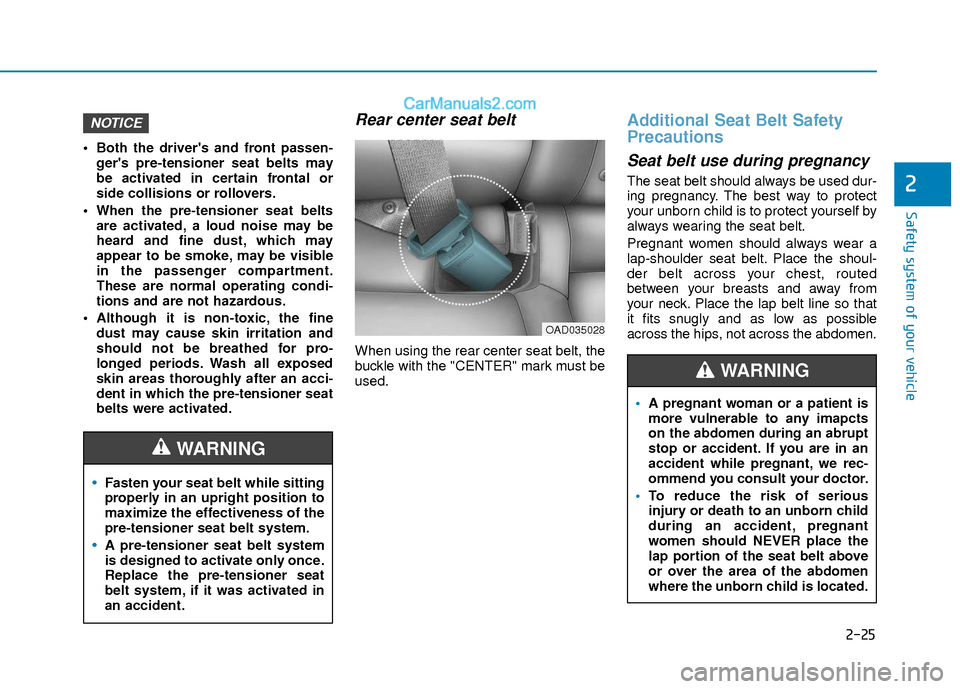
2-25
Safety system of your vehicle
2
Both the driver's and front passen-ger's pre-tensioner seat belts may
be activated in certain frontal or
side collisions or rollovers.
When the pre-tensioner seat belts are activated, a loud noise may be
heard and fine dust, which may
appear to be smoke, may be visible
in the passenger compartment.
These are normal operating condi-
tions and are not hazardous.
Although it is non-toxic, the fine dust may cause skin irritation and
should not be breathed for pro-
longed periods. Wash all exposed
skin areas thoroughly after an acci-
dent in which the pre-tensioner seat
belts were activated.
Rear center seat belt
When using the rear center seat belt, the
buckle with the "CENTER" mark must be
used.
Additional Seat Belt Safety
Precautions
Seat belt use during pregnancy
The seat belt should always be used dur-
ing pregnancy. The best way to protect
your unborn child is to protect yourself by
always wearing the seat belt.
Pregnant women should always wear a
lap-shoulder seat belt. Place the shoul-
der belt across your chest, routed
between your breasts and away from
your neck. Place the lap belt line so that
it fits snugly and as low as possible
across the hips, not across the abdomen.
NOTICE
Fasten your seat belt while sitting
properly in an upright position to
maximize the effectiveness of the
pre-tensioner seat belt system.
A pre-tensioner seat belt system
is designed to activate only once.
Replace the pre-tensioner seat
belt system, if it was activated in
an accident.
WARNING
OAD035028
A pregnant woman or a patient is
more vulnerable to any imapcts
on the abdomen during an abrupt
stop or accident. If you are in an
accident while pregnant, we rec-
ommend you consult your doctor.
To reduce the risk of serious
injury or death to an unborn child
during an accident, pregnant
women should NEVER place the
lap portion of the seat belt above
or over the area of the abdomen
where the unborn child is located.
WARNING
Page 43 of 526
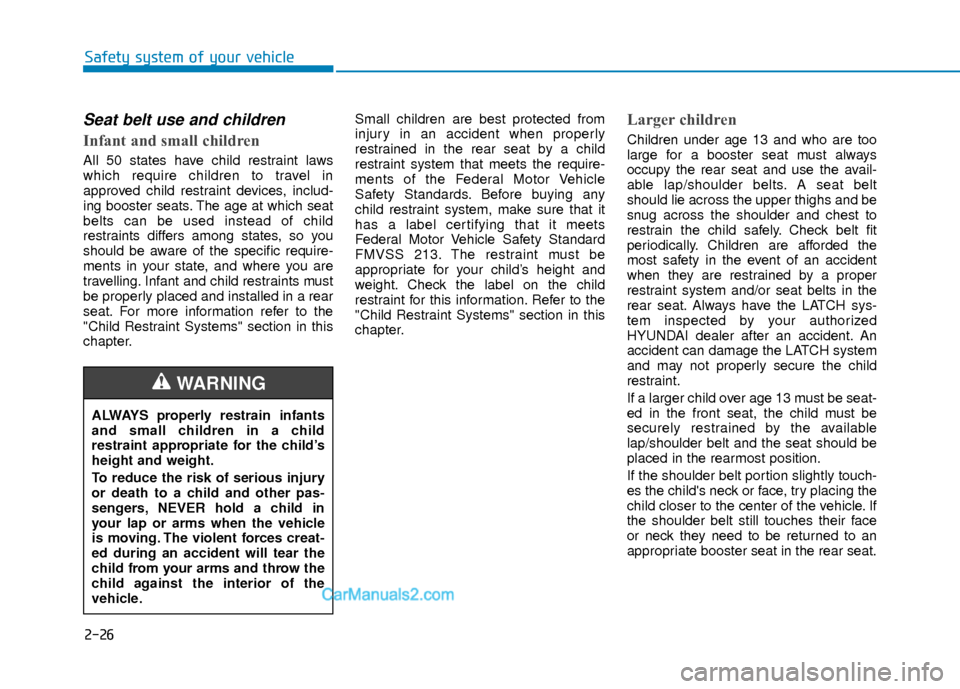
2-26
Safety system of your vehicle
Seat belt use and children
Infant and small children
All 50 states have child restraint laws
which require children to travel in
approved child restraint devices, includ-
ing booster seats. The age at which seat
belts can be used instead of child
restraints differs among states, so you
should be aware of the specific require-
ments in your state, and where you are
travelling. Infant and child restraints must
be properly placed and installed in a rear
seat. For more information refer to the
"Child Restraint Systems" section in this
chapter.Small children are best protected from
injury in an accident when properly
restrained in the rear seat by a child
restraint system that meets the require-
ments of the Federal Motor Vehicle
Safety Standards. Before buying any
child restraint system, make sure that it
has a label certifying that it meets
Federal Motor Vehicle Safety Standard
FMVSS 213. The restraint must be
appropriate for your child’s height and
weight. Check the label on the child
restraint for this information. Refer to the
"Child Restraint Systems" section in this
chapter.
Larger children
Children under age 13 and who are too
large for a booster seat must always
occupy the rear seat and use the avail-
able lap/shoulder belts. A seat belt
should lie across the upper thighs and be
snug across the shoulder and chest to
restrain the child safely. Check belt fit
periodically. Children are afforded the
most safety in the event of an accident
when they are restrained by a proper
restraint system and/or seat belts in the
rear seat. Always have the LATCH sys-
tem inspected by your authorized
HYUNDAI dealer after an accident. An
accident can damage the LATCH system
and may not properly secure the child
restraint.
If a larger child over age 13 must be seat-
ed in the front seat, the child must be
securely restrained by the available
lap/shoulder belt and the seat should be
placed in the rearmost position.
If the shoulder belt portion slightly touch-
es the child's neck or face, try placing the
child closer to the center of the vehicle. If
the shoulder belt still touches their face
or neck they need to be returned to an
appropriate booster seat in the rear seat.
ALWAYS properly restrain infants
and small children in a child
restraint appropriate for the child’s
height and weight.
To reduce the risk of serious injury
or death to a child and other pas-
sengers, NEVER hold a child in
your lap or arms when the vehicle
is moving. The violent forces creat-
ed during an accident will tear the
child from your arms and throw the
child against the interior of the
vehicle.
WARNING
Page 44 of 526
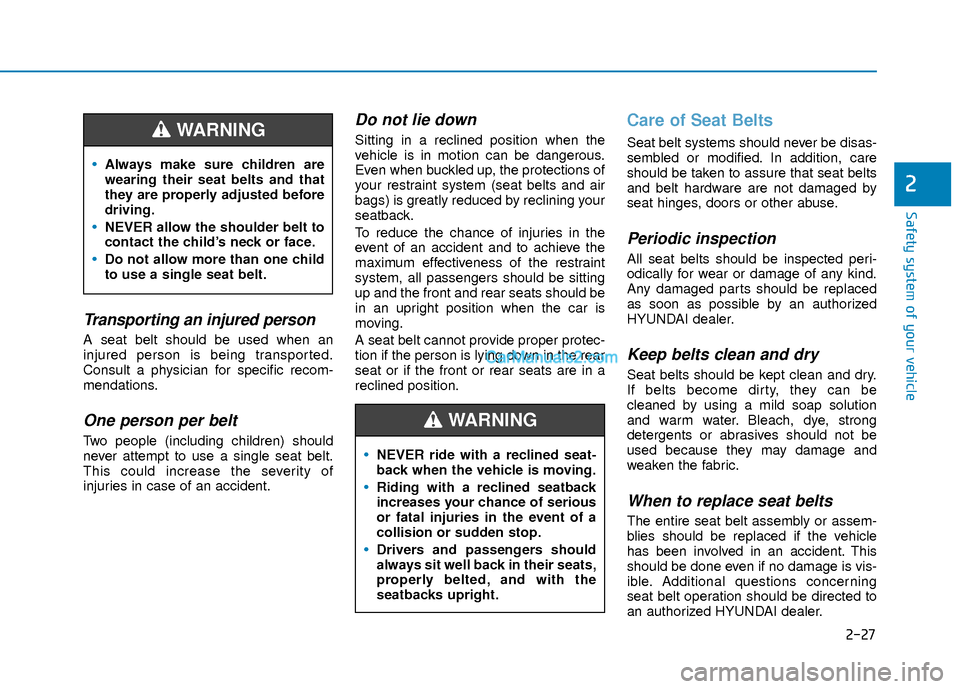
2-27
Safety system of your vehicle
2
Transporting an injured person
A seat belt should be used when an
injured person is being transported.
Consult a physician for specific recom-
mendations.
One person per belt
Two people (including children) should
never attempt to use a single seat belt.
This could increase the severity of
injuries in case of an accident.
Do not lie down
Sitting in a reclined position when the
vehicle is in motion can be dangerous.
Even when buckled up, the protections of
your restraint system (seat belts and air
bags) is greatly reduced by reclining your
seatback.
To reduce the chance of injuries in the
event of an accident and to achieve the
maximum effectiveness of the restraint
system, all passengers should be sitting
up and the front and rear seats should be
in an upright position when the car is
moving.
A seat belt cannot provide proper protec-
tion if the person is lying down in the rear
seat or if the front or rear seats are in a
reclined position.
Care of Seat Belts
Seat belt systems should never be disas-
sembled or modified. In addition, care
should be taken to assure that seat belts
and belt hardware are not damaged by
seat hinges, doors or other abuse.
Periodic inspection
All seat belts should be inspected peri-
odically for wear or damage of any kind.
Any damaged parts should be replaced
as soon as possible by an authorized
HYUNDAI dealer.
Keep belts clean and dry
Seat belts should be kept clean and dry.
If belts become dirty, they can be
cleaned by using a mild soap solution
and warm water. Bleach, dye, strong
detergents or abrasives should not be
used because they may damage and
weaken the fabric.
When to replace seat belts
The entire seat belt assembly or assem-
blies should be replaced if the vehicle
has been involved in an accident. This
should be done even if no damage is vis-
ible. Additional questions concerning
seat belt operation should be directed to
an authorized HYUNDAI dealer.
Always make sure children are
wearing their seat belts and that
they are properly adjusted before
driving.
NEVER allow the shoulder belt to
contact the child’s neck or face.
Do not allow more than one child
to use a single seat belt.
WARNING
NEVER ride with a reclined seat-
back when the vehicle is moving.
Riding with a reclined seatback
increases your chance of serious
or fatal injuries in the event of a
collision or sudden stop.
Drivers and passengers should
always sit well back in their seats,
properly belted, and with the
seatbacks upright.
WARNING
Page 45 of 526
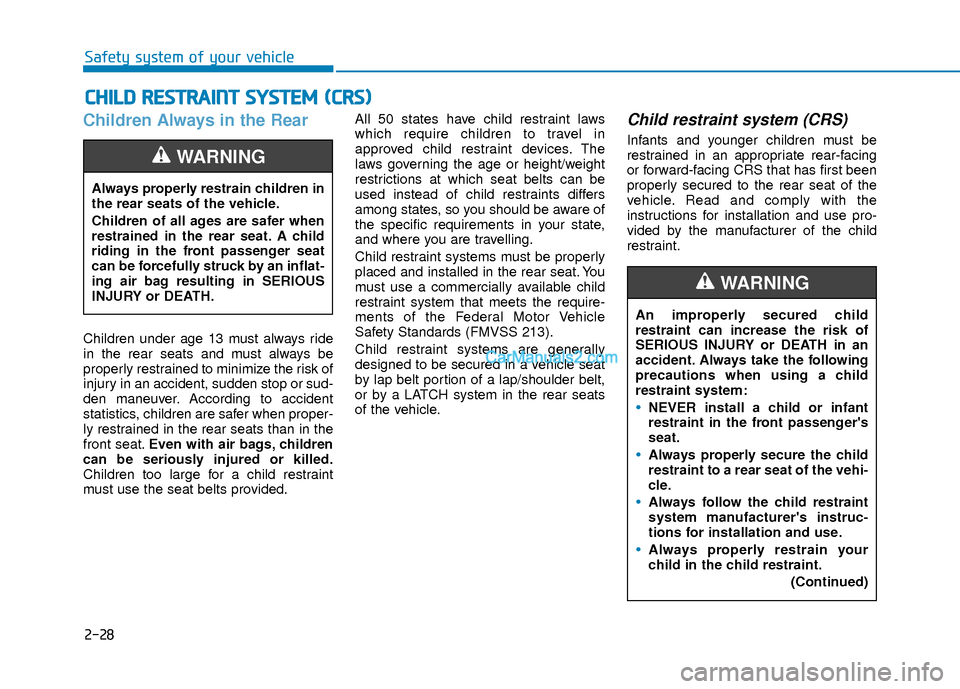
2-28
Safety system of your vehicle
Children Always in the Rear
Children under age 13 must always ride
in the rear seats and must always be
properly restrained to minimize the risk of
injury in an accident, sudden stop or sud-
den maneuver. According to accident
statistics, children are safer when proper-
ly restrained in the rear seats than in the
front seat.Even with air bags, children
can be seriously injured or killed.
Children too large for a child restraint
must use the seat belts provided. All 50 states have child restraint laws
which require children to travel in
approved child restraint devices. The
laws governing the age or height/weight
restrictions at which seat belts can be
used instead of child restraints differs
among states, so you should be aware of
the specific requirements in your state,
and where you are travelling.
Child restraint systems must be properly
placed and installed in the rear seat. You
must use a commercially available child
restraint system that meets the require-
ments of the Federal Motor Vehicle
Safety Standards (FMVSS 213).
Child restraint systems are generally
designed to be secured in a vehicle seat
by lap belt portion of a lap/shoulder belt,
or by a LATCH system in the rear seats
of the vehicle.
Child restraint system (CRS)
Infants and younger children must be
restrained in an appropriate rear-facing
or forward-facing CRS that has first been
properly secured to the rear seat of the
vehicle. Read and comply with the
instructions for installation and use pro-
vided by the manufacturer of the child
restraint.
C C
H
H I
IL
L D
D
R
R E
ES
ST
T R
R A
A I
IN
N T
T
S
S Y
Y S
ST
T E
EM
M
(
( C
C R
R S
S)
)
Always properly restrain children in
the rear seats of the vehicle.
Children of all ages are safer when
restrained in the rear seat. A child
riding in the front passenger seat
can be forcefully struck by an inflat-
ing air bag resulting in SERIOUS
INJURY or DEATH.
WARNING
An improperly secured child
restraint can increase the risk of
SERIOUS INJURY or DEATH in an
accident. Always take the following
precautions when using a child
restraint system:
NEVER install a child or infant
restraint in the front passenger's
seat.
Always properly secure the child
restraint to a rear seat of the vehi-
cle.
Always follow the child restraint
system manufacturer's instruc-
tions for installation and use.
Always properly restrain your
child in the child restraint.
(Continued)
WARNING
Page 46 of 526
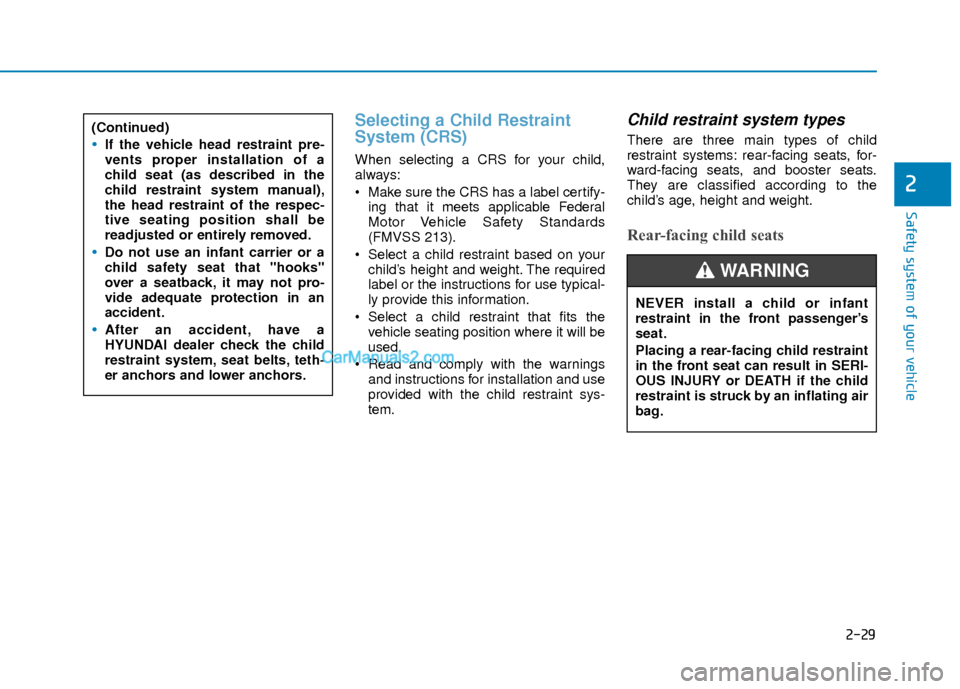
2-29
Safety system of your vehicle
2
Selecting a Child Restraint
System (CRS)
When selecting a CRS for your child,
always:
Make sure the CRS has a label certify-ing that it meets applicable Federal
Motor Vehicle Safety Standards
(FMVSS 213).
Select a child restraint based on your child’s height and weight. The required
label or the instructions for use typical-
ly provide this information.
Select a child restraint that fits the vehicle seating position where it will be
used.
Read and comply with the warnings and instructions for installation and use
provided with the child restraint sys-
tem.
Child restraint system types
There are three main types of child
restraint systems: rear-facing seats, for-
ward-facing seats, and booster seats.
They are classified according to the
child’s age, height and weight.
Rear-facing child seats
(Continued)
If the vehicle head restraint pre-
vents proper installation of a
child seat (as described in the
child restraint system manual),
the head restraint of the respec-
tive seating position shall be
readjusted or entirely removed.
Do not use an infant carrier or a
child safety seat that "hooks"
over a seatback, it may not pro-
vide adequate protection in an
accident.
After an accident, have a
HYUNDAI dealer check the child
restraint system, seat belts, teth-
er anchors and lower anchors.
NEVER install a child or infant
restraint in the front passenger’s
seat.
Placing a rear-facing child restraint
in the front seat can result in SERI-
OUS INJURY or DEATH if the child
restraint is struck by an inflating air
bag.
WARNING
Page 47 of 526
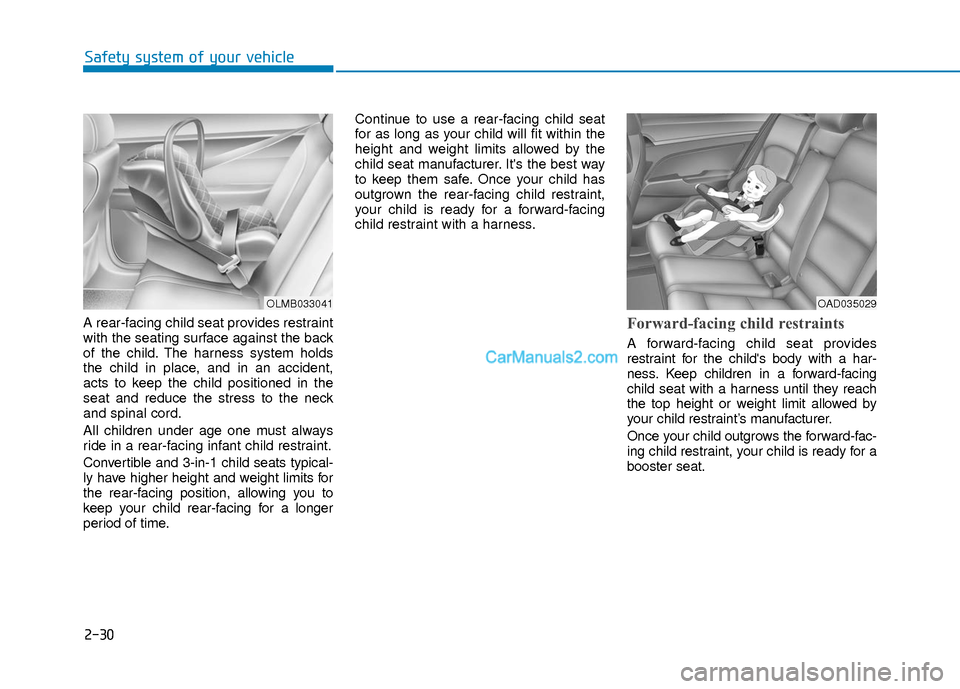
2-30
Safety system of your vehicle
A rear-facing child seat provides restraint
with the seating surface against the back
of the child. The harness system holds
the child in place, and in an accident,
acts to keep the child positioned in the
seat and reduce the stress to the neck
and spinal cord.
All children under age one must always
ride in a rear-facing infant child restraint.
Convertible and 3-in-1 child seats typical-
ly have higher height and weight limits for
the rear-facing position, allowing you to
keep your child rear-facing for a longer
period of time.Continue to use a rear-facing child seat
for as long as your child will fit within the
height and weight limits allowed by the
child seat manufacturer. It's the best way
to keep them safe. Once your child has
outgrown the rear-facing child restraint,
your child is ready for a forward-facing
child restraint with a harness.Forward-facing child restraints
A forward-facing child seat provides
restraint for the child's body with a har-
ness. Keep children in a forward-facing
child seat with a harness until they reach
the top height or weight limit allowed by
your child restraint’s manufacturer.
Once your child outgrows the forward-fac-
ing child restraint, your child is ready for a
booster seat.
OLMB033041OAD035029
Page 48 of 526
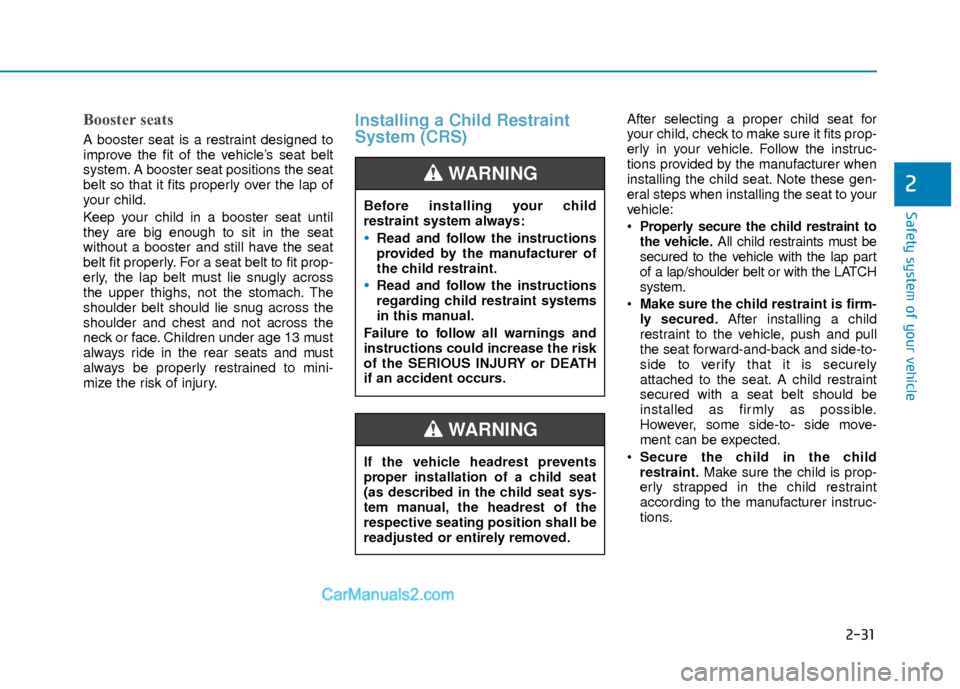
2-31
Safety system of your vehicle
2
Booster seats
A booster seat is a restraint designed to
improve the fit of the vehicle’s seat belt
system. A booster seat positions the seat
belt so that it fits properly over the lap of
your child.
Keep your child in a booster seat until
they are big enough to sit in the seat
without a booster and still have the seat
belt fit properly. For a seat belt to fit prop-
erly, the lap belt must lie snugly across
the upper thighs, not the stomach. The
shoulder belt should lie snug across the
shoulder and chest and not across the
neck or face. Children under age 13 must
always ride in the rear seats and must
always be properly restrained to mini-
mize the risk of injury.
Installing a Child Restraint
System (CRS)After selecting a proper child seat for
your child, check to make sure it fits prop-
erly in your vehicle. Follow the instruc-
tions provided by the manufacturer when
installing the child seat. Note these gen-
eral steps when installing the seat to your
vehicle:
Properly secure the child restraint to
the vehicle.All child restraints must be
secured to the vehicle with the lap part
of a lap/shoulder belt or with the LATCH
system.
Make sure the child restraint is firm-
ly secured. After installing a child
restraint to the vehicle, push and pull
the seat forward-and-back and side-to-
side to verify that it is securely
attached to the seat. A child restraint
secured with a seat belt should be
installed as firmly as possible.
However, some side-to- side move-
ment can be expected.
Secure the child in the child
restraint. Make sure the child is prop-
erly strapped in the child restraint
according to the manufacturer instruc-
tions.
Before installing your child
restraint system always:Read and follow the instructions
provided by the manufacturer of
the child restraint.
Read and follow the instructions
regarding child restraint systems
in this manual.
Failure to follow all warnings and
instructions could increase the risk
of the SERIOUS INJURY or DEATH
if an accident occurs.
WARNING
If the vehicle headrest prevents
proper installation of a child seat
(as described in the child seat sys-
tem manual, the headrest of the
respective seating position shall be
readjusted or entirely removed.
WARNING
Page 49 of 526
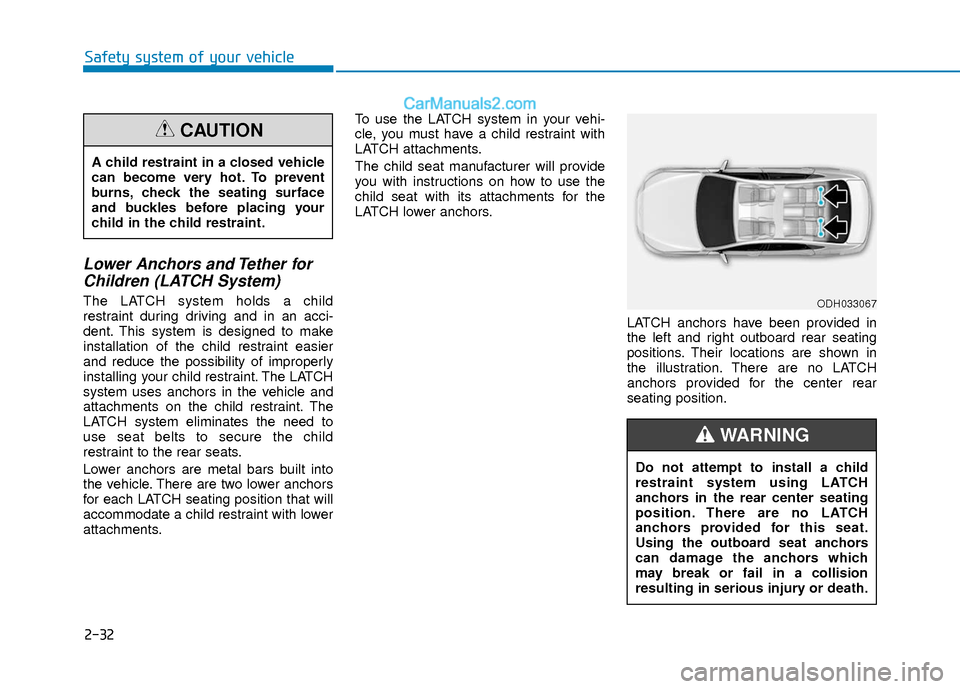
2-32
Safety system of your vehicle
Lower Anchors and Tether forChildren (LATCH System)
The LATCH system holds a child
restraint during driving and in an acci-
dent. This system is designed to make
installation of the child restraint easier
and reduce the possibility of improperly
installing your child restraint. The LATCH
system uses anchors in the vehicle and
attachments on the child restraint. The
LATCH system eliminates the need to
use seat belts to secure the child
restraint to the rear seats.
Lower anchors are metal bars built into
the vehicle. There are two lower anchors
for each LATCH seating position that will
accommodate a child restraint with lower
attachments. To use the LATCH system in your vehi-
cle, you must have a child restraint with
LATCH attachments.
The child seat manufacturer will provide
you with instructions on how to use the
child seat with its attachments for the
LATCH lower anchors.
LATCH anchors have been provided in
the left and right outboard rear seating
positions. Their locations are shown in
the illustration. There are no LATCH
anchors provided for the center rear
seating position.
A child restraint in a closed vehicle
can become very hot. To prevent
burns, check the seating surface
and buckles before placing your
child in the child restraint.
CAUTION
ODH033067
Do not attempt to install a child
restraint system using LATCH
anchors in the rear center seating
position. There are no LATCH
anchors provided for this seat.
Using the outboard seat anchors
can damage the anchors which
may break or fail in a collision
resulting in serious injury or death.
WARNING
Page 50 of 526
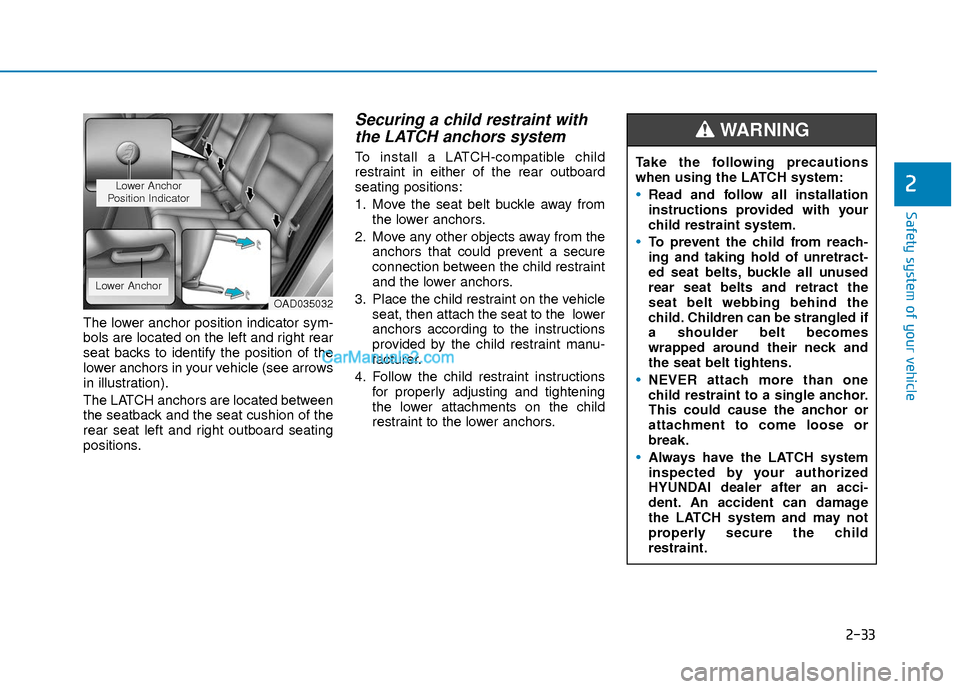
2-33
Safety system of your vehicle
2
The lower anchor position indicator sym-
bols are located on the left and right rear
seat backs to identify the position of the
lower anchors in your vehicle (see arrows
in illustration).
The LATCH anchors are located between
the seatback and the seat cushion of the
rear seat left and right outboard seating
positions.
Securing a child restraint withthe LATCH anchors system
To install a LATCH-compatible child
restraint in either of the rear outboard
seating positions:
1. Move the seat belt buckle away from
the lower anchors.
2. Move any other objects away from the anchors that could prevent a secure
connection between the child restraint
and the lower anchors.
3. Place the child restraint on the vehicle seat, then attach the seat to the lower
anchors according to the instructions
provided by the child restraint manu-
facturer.
4. Follow the child restraint instructions for properly adjusting and tightening
the lower attachments on the child
restraint to the lower anchors.
OAD035032
Lower Anchor
Position Indicator
Lower Anchor
Take the following precautions
when using the LATCH system:
Read and follow all installation
instructions provided with your
child restraint system.
To prevent the child from reach-
ing and taking hold of unretract-
ed seat belts, buckle all unused
rear seat belts and retract the
seat belt webbing behind the
child. Children can be strangled if
a shoulder belt becomes
wrapped around their neck and
the seat belt tightens.
NEVER attach more than one
child restraint to a single anchor.
This could cause the anchor or
attachment to come loose or
break.
Always have the LATCH system
inspected by your authorized
HYUNDAI dealer after an acci-
dent. An accident can damage
the LATCH system and may not
properly secure the child
restraint.
WARNING